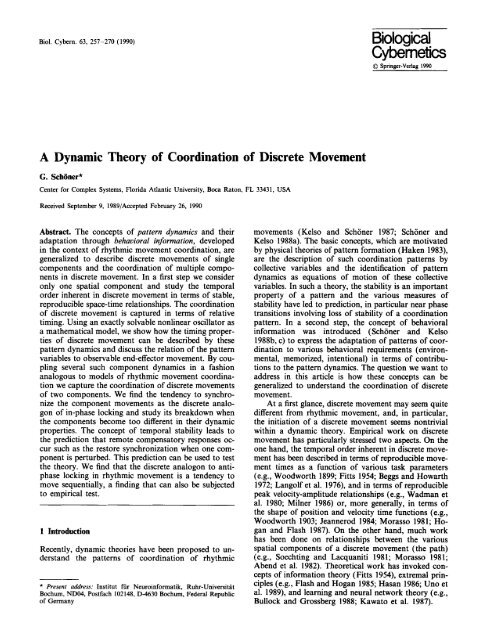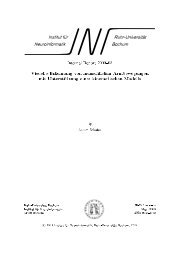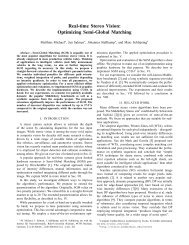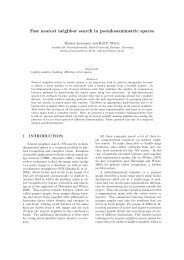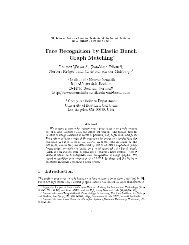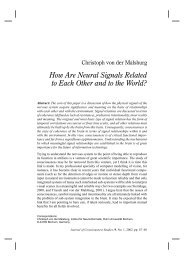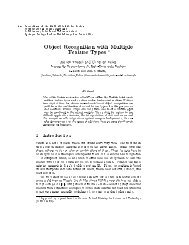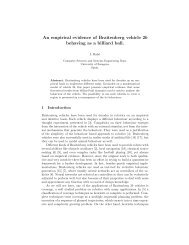A dynamic theory of coordination of discrete movement - Free
A dynamic theory of coordination of discrete movement - Free
A dynamic theory of coordination of discrete movement - Free
You also want an ePaper? Increase the reach of your titles
YUMPU automatically turns print PDFs into web optimized ePapers that Google loves.
265described by the pattern <strong>dynamic</strong>s, (19). This questionwas briefly discussed for rhythmic <strong>movement</strong> in Sect. 2in the context <strong>of</strong> phase resetting analysis (Kay et al.1990). In the case <strong>of</strong> <strong>discrete</strong> <strong>movement</strong> a perturbation<strong>of</strong> the <strong>coordination</strong> system Eq. (19) leads to relaxationback towards the phase plane curve (x, v) given by thelimit cycle attractor solution in the presence <strong>of</strong> behavioralinformation and towards the target fixed point inthe absence <strong>of</strong> behavioral information. The positionaltrajectory, x(t), itself is not stable, however. This isevident from the simulations shown in Fig. 5, where aperturbed trajectory is compared to an unperturbed one.While the phase plane trajectories <strong>of</strong> the two solutionsconverge, the spatial trajectories do not converge (due toa shift in the phase <strong>of</strong> the underlying oscillator).In experiments with monkeys who performed <strong>discrete</strong><strong>movement</strong>s towards learned visual targets Bizzixa2.50.0-2.5v0.0-50-10050.0,-g,E0.0-50.0-100.0L9 //"".. _ .--1.0 2.0 time [s Iii/ ..'" "'J-150.0-5.0 ~2.5 0.0 '2.5 5.0ix[cm]Fig. 5a, b. Simulations <strong>of</strong> (19) at the standard parameter values (25).Here an unperturbed solution (solid lines) is shown together with asolution that was perturbed at t = 1.1 s to assist the <strong>movement</strong>(velocity advanced: v =-2.3--+-50crn/s). In panel a the spatialtrajectories are shown together with their velocities. Note that there isno tendency to relax back to the unperturbed trajectory. By contrast,the phase plane trajectories shown in panel b converge due torelaxation <strong>of</strong> the perturbed solutionand colleagues (Bizzi and Abend 1982; Bizzi et al. 1982)found that perturbations assisting the <strong>movement</strong> (similaras in the simulation <strong>of</strong> Fig. 5) can lead to relaxationback toward the typical unperturbed trajectory. (Theeffect was particularly clear in deafferented preparations.)In the present framework this means that theunderlying <strong>coordination</strong> system was not perturbed, sothat the end-effector relaxes to the trajectory defined bythe <strong>coordination</strong> system. To address such effects wemust explicitly model the relationship between endeffectorand <strong>coordination</strong> system (cf. Discussion).5 Coordinated Discrete Movement: Model and ResultsAn important experimental result on interlimb <strong>coordination</strong><strong>of</strong> <strong>discrete</strong> <strong>movement</strong> can be expressed as atendency to synchronize the <strong>movement</strong>s <strong>of</strong> differentlimbs. Kelso et al. (1979a) studied a bimanual task, inwhich each hand moved from a home key to a target.By varying the distance and the precision requirementsfor each target, the index <strong>of</strong> difficulty in the sense <strong>of</strong>Fitts' law (Fitts' 1954) could be varied. As a result, the<strong>movement</strong> times in single hand <strong>movement</strong> could bevaried by almost a factor <strong>of</strong> two. If the <strong>movement</strong>s hadto be performed with the two hands simultaneously,one hand to a difficult (far, small) target, the other toan easy (near, large) target, the <strong>movement</strong> times <strong>of</strong>both hands were almost identical. Essentially, the fasthand was slowed down to move synchronously with theslow hand. Further studies in similar paradigms confirmedthis tendency to synchronize <strong>discrete</strong> <strong>movement</strong>s<strong>of</strong> different limbs and showed the breakdown <strong>of</strong> synchronizationwhen the intrinsic <strong>movement</strong> times <strong>of</strong> thetwo limbs become too dissimilar (Kelso et al. 1983;Marteniuk et al. 1984; Corcos 1984).To model the <strong>coordination</strong> <strong>of</strong> two end-effectors, weintroduce a single effector description for each limb.Each structure's collective variables, (xi, vi) withi = l, 2, are assumed to be governed by <strong>dynamic</strong>s <strong>of</strong> theform <strong>of</strong> (19):Yc =v iD = --f/, total(Xi,/)i) (27)= --{a 2 + co2i + •[q, ti+Ati](t)Cintent, i}Xi+ 2ajvi - 4bix2vi + 2aibix~ 2 5 -bixi+ x/~irWe introduce a different set <strong>of</strong> parameters for eachend-effector to express different <strong>movement</strong> conditions<strong>of</strong> the two limbs.The <strong>coordination</strong> tendency is captured by couplingthe two intrinsic <strong>dynamic</strong>s. A similar coupling structureas used in the earlier work on rhythmic <strong>movement</strong>s(Haken et al. 1985; cf. Sect. 2, (2)) can be used. Unlikein this earlier work, however, we treat here cases inwhich the two limbs are not equivalent but may, forexample, differ in <strong>movement</strong> amplitude and limit cyclefrequency. In such cases, the coupling functions as usedin (2) are dominated by one component and do notlead to a synchronization tendency. Coupling functions
266that account for the tendency <strong>of</strong> synchronization also inasymmetric cases can be obtained by normalizing eachcontribution. Such normalization can be based on the<strong>movement</strong> amplitude, Ai, and peak velocity, Vi.p, asestimated in the harmonic balance approximation:(i = 1, 2)Ae = ~/ b, ' v,,, ~ Io~,lA, (28)or similar measures. The coupled system is then:.~] = v l~)l=--fl, total(Xl'Vl)--k(V-~,p I)V~,; )3C 2 = V 2-t Z Z//)2: --f2, total(X2'V2)--k ( UV~,2p UU~I;)(29)where k and l are coupling constants. In the rrgime <strong>of</strong>stable limit cycle solutions, that is, when both oscillatorsare in part (e) <strong>of</strong> the phase diagram at moderatecoupling strengths, the same results as obtained in theearlier work (Haken et al. t985) are reproduced.To address the <strong>coordination</strong> <strong>of</strong> <strong>discrete</strong> <strong>movement</strong>we study the case, where the two components havedifferent <strong>movement</strong> amplitudes and <strong>movement</strong> timesindividually. In the model this corresponds to choosingthe parameters <strong>of</strong> each component such that they correspondto different points within the parameterization <strong>of</strong>FiRs' law (Fig. 4). For example, by selecting a small]coT[ value for x~ (with bl chosen correspondingly, cf.Sect. 4), we may endow this component with a small<strong>movement</strong> amplitude and a small <strong>movement</strong> time (seeFig. 6, top panel, solid line). The other component, x2,may make a large amplitude <strong>movement</strong> with larger<strong>movement</strong> time, if its og~-parameter is chosen corre,spondingly (Fig. 6, top panel, dashed line). When thetwo components are coupled, corresponding to thesimultaneous performance <strong>of</strong> the <strong>discrete</strong> <strong>movement</strong>s,we observe the synchronization <strong>of</strong> the <strong>movement</strong>s (Fig.6, bottom panel) although the <strong>movement</strong> amplitudesare unchanged and thus still different. This result is anaccount <strong>of</strong> Kelso et al. (1979a) observations. (We aretaking into account only one spatial component <strong>of</strong> the<strong>movement</strong>, e.g., the projection <strong>of</strong> the <strong>movement</strong> ontothe line connecting target and initial position. This islegitimate in the absence <strong>of</strong> any effect in the space curve<strong>of</strong> the <strong>movement</strong>.) We remark, that the tendency <strong>of</strong>synchronization persists when in the model the parameters<strong>of</strong> behavioral information, A t; and Cintent ' i are differentfor the two components (see Fig. 9).If we make the <strong>movement</strong> conditions more dissimilar,the tendency to synchronization is no longer strongenough to achieve complete simultaneity and a breakdown<strong>of</strong> synchronization is observed. In Fig. 7 the twox [cml10 ....... "'",0.0 ~-10 ',x [em]....................... --410 "'"---...,0.0 ~,-lo1.0 2.0 time [s]iii I1.0 2.0 time [s]IFig. 6. Top panel: Two components in <strong>discrete</strong> <strong>movement</strong> withdifferent amplitudes and <strong>movement</strong> times. The solid line is a solutionat the standard parameter set [(25), leading to <strong>movement</strong> amplitudeA = 6.85cm and (half-distance) <strong>movement</strong> time To=0.53 sl. Thedashed line is a solution with larger amplitude and <strong>movement</strong> time[m2= _5Hz 2 and b =0.0794Hz/cm 2, leading to A =25cm andT o = 0.77 s]. Both <strong>movement</strong>s are initiated at t = 1.0. The two componentsare uncoupled in the top panel corresponding to individual<strong>movement</strong>s. In the bottom panel the same conditions prevail, but thecomponents are coupled (k =-40Hz2), corresponding to simultaneousperformance <strong>of</strong> the <strong>movement</strong>s. Note the almost perfect synchronization<strong>of</strong> the <strong>movement</strong>sx [ore20 ........................100.0 '~K_-10-20 1.0x Eoml20 ..........................10 "",0.0-i0-20 1.02 0 ." .... time Is]Fig. 7. Similar to Fig. 6, but the second component (dashed line) hasparameter values ~o 2 = -5.5 Hz (b 2 = 0.036 Hz/cm2), so that its amplitudeand <strong>movement</strong> time are even further removed from those <strong>of</strong>the first component in individual <strong>movement</strong> (top panel). When coupled(bottom panel) with the same strength as in Fig. 6, the twocomponents still tend to synchronize, but do not achieve the samedegree <strong>of</strong> simultaneity
267individual <strong>movement</strong>s differ more strongly in <strong>movement</strong>amplitude and hence <strong>movement</strong> time (top panel)and evidently their synchronization is less complete(bottom panel) than in the case <strong>of</strong> Fig. 6. This accountsfor the gradual breakdown <strong>of</strong> synchronization reportedin Marteniuk et al. (1984) and Corcos (1984), as the<strong>movement</strong> conditions for the two components were••lO0.0-10100.0-10Xltcm]•100.0-10100.0-101.0 2.0 time [s]1.0 2.0 time [s]1.012.0 time [s]1.0 2.0 time [s]Fig. 8a, b. The coordinated <strong>movement</strong>s (with coupling) shown in Fig.6 are reproduced as solid hnes: the small amplitude component in thetop, and the large amplitude component in the bottom panel. Thedashed lines show simulations at the same parameter values in whichone component was perturbed at t = 1.2 s. In panel a <strong>of</strong> the figure theintrinsically faster component x~ (top) is perturbed to assist the<strong>movement</strong> (xl ~ 3 cm ~ 2 cm, v ~ - 2 cm/s ~ - 4 cm/s), leading to aspeeding up <strong>of</strong> the unperturbed component to restore synchronization.In panel b the intrinsically slower component x2 (bottom) isperturbed to delay its <strong>movement</strong> (v I ~ -8 em/s--, +50 cm/s) leadingto a slowing down <strong>of</strong> the unperturbed component again to restoresynchronization3-made more dissimilar. A similar breakdown <strong>of</strong> synchronizationwas observed by Kelso et al. (1983), when theyplaced an obstacle in the <strong>movement</strong> path <strong>of</strong> one componentso that its space curve and hence <strong>movement</strong> timebecame much longer than that <strong>of</strong> the other hand.In the present theoretical account the tendency tosynchronize <strong>discrete</strong> <strong>movement</strong> is due to the formation<strong>of</strong> a stable <strong>coordination</strong> pattern between the two components.This leads to the prediction that a remotecompensatory reaction occurs in one component, if theother component is perturbed. (In light <strong>of</strong> previousdiscussion it is clear that the perturbation must besufficiently strong to affect the nervous system level <strong>of</strong><strong>coordination</strong> modelled here.) Moreover, the remotecompensatory responses are such as to restore the<strong>coordination</strong> pattern, that is, to restore synchronization.We demonstrate this phenomenon for the modelin Fig. 8. The two components perform <strong>movement</strong>swith different <strong>movement</strong> amplitudes, but identical<strong>movement</strong> times due to coupling (solid lines <strong>of</strong> Fig. 8are the same trajectories as shown before in the lowerpanel <strong>of</strong> Fig. 6). In Fig. 8a we perturb component x~ toassist its <strong>movement</strong> (top panel, dashed line). We observean effect in the unperturbed component (bottompanel, dashed line): this component is also advanced inits <strong>movement</strong>, that means, the compensatory responsetries to restore synchronization. Figure 8b shows thesame effect when we perturb the slower component, x2,delaying its <strong>movement</strong> (lower panel, dashed line). Inthis case the effect in the other component is to movemore slowly (top panel, dashed line), again in thedirection <strong>of</strong> restoring synchronization.It would be very interesting to try to observe such aphenomenon in experiment, because this prediction isdue to the conceptual structure <strong>of</strong> the present <strong>theory</strong>rather than to the detailed modelling assumptions. Experimentson perturbations <strong>of</strong> the <strong>movement</strong>s <strong>of</strong> articulatorsin repetitive speech contain hints at such aneffect. For example, Kelso et al. (1984) perturbed thejaw during various utterances and observed fast compensatoryreactions in the upper lip if it was functionallynecessary to achieve final lip closure. Recently,Gracco and Abbs (1988) showed, that in similar situationsthe compensatory <strong>movement</strong> <strong>of</strong> the remote articulatoris such as to restore the normal relative timing <strong>of</strong>different articulators.Finally, we examine the consequences <strong>of</strong> the nonlinearcoupling measured by the coupling coefficient/, thatwas introduced to account for anti-phase locking inrhythmic <strong>movement</strong> (see Haken et al. 1985). Whatcould anti-phase locking mean in the case <strong>of</strong> <strong>discrete</strong><strong>movement</strong>? The attraction to a relative timing correspondingto anti-phase locking leads to a tendency toperform two <strong>movement</strong>s sequentially. Thus, if two <strong>discrete</strong><strong>movement</strong>s are initiated with sufficient delay (inthe model: to, ~ different from to. 2), the <strong>movement</strong> time<strong>of</strong> the delayed <strong>movement</strong> increases to make the <strong>movement</strong>occur with less temporal overlap. In Fig. 9 weshow two components moving with the same amplitude(standard parameter set, (25)), either individually (i.e.,uncoupled: solid lines) or together (i.e., coupled: dashed
268Xl[cml5<strong>coordination</strong> pattern so that the predictions about remotecompensatory responses arise analogously as forthe synchronization tendency.0.0-5~2[cm50.0-51.0i1.0J2.0itime [s]2.0 time [s]Fig. 9. Two identical components perform <strong>movement</strong>s with the sameamplitude (standard parameter set, but At = 0.5 to allow for largerdelays). The solid lines represent the same solution with <strong>movement</strong>initiation at to, L= 1.0 s (top) and to, 2 = 1.2 s (left trace in bottompanel). A second simulation is shown in the same panels withidentical first component and <strong>movement</strong> initiation <strong>of</strong> the secondcomponent at t~, 2 = 1.4 s (right trace in bottom panel). If the twocomponents are coupled (dashed lines) with the full nonlinear coupling(k = - 10 Hz 2, l = 10 Hz2), the tendencies to synchronization orto sequentialization can be observed depending on the delay betweenthe <strong>movement</strong> initiations <strong>of</strong> the two components. For small delay(=0.2 s: left dashed traces) the synchronization tendency prevailsleading to shorter <strong>movement</strong> time <strong>of</strong> the delayed component. Forlarge delay (=0.4 s: right dashed traces) the sequentialization tendencyprevails leading to larger <strong>movement</strong> time <strong>of</strong> the delayedcomponentlines). If the onset <strong>of</strong> behavioral information <strong>of</strong> thesecond component (bottom panel) is delayed by a smallamount compared to the first component (bottompanel, left solid line), the synchronization tendencyshortens the <strong>movement</strong> time <strong>of</strong> the second componentto restore synchronizity (bottom panel, left dashedline). If this delay becomes sufficiently large (bottompanel, right solid line), however, the tendency to sequential<strong>movement</strong> leads to a larger <strong>movement</strong> time <strong>of</strong>the second component, so that this <strong>movement</strong> overlapslittle with the <strong>movement</strong> <strong>of</strong> the first component.The numerical simulation suggests an experimentalparadigm to test whether such a <strong>coordination</strong> tendency<strong>of</strong> sequencial <strong>movement</strong> exists: In bimanual, fast <strong>movement</strong>,"go" signals are given separately for each limb.The delay between these go signals is manipulatedsystematically and <strong>movement</strong> time is measured. Theprediction is that for small delay, the <strong>movement</strong>s willtend to synchronize, while for larger delay, the <strong>movement</strong>times will adjust so as to produce more sequential<strong>movement</strong>. (Because <strong>movement</strong> times and reactiontimes can be measured separately, complications relatingto the information processing, e.g., psychologicalrefractory period, may be kept separate from the issue<strong>of</strong> <strong>coordination</strong>.) In this <strong>theory</strong>, such a tendency tomove sequentially is also due to the formation <strong>of</strong> aL6 ConclusionWe have shown how a <strong>dynamic</strong> <strong>theory</strong> <strong>of</strong> <strong>discrete</strong><strong>movement</strong> can be constructed on the basis <strong>of</strong> local<strong>dynamic</strong> descriptions <strong>of</strong> the initial and target posturalstates. The intention to move is captured as behavioralinformation, a part <strong>of</strong> the <strong>dynamic</strong>s that stabilizes alimit cycle over a limited period <strong>of</strong> time. The timing <strong>of</strong>the <strong>movement</strong> is then largely determined by the intrinsic<strong>dynamic</strong>s in the absence <strong>of</strong> an intention to move.We have shown that <strong>movement</strong> time-amplitude relationshipscan be captured in terms <strong>of</strong> relations amongthe parameters <strong>of</strong> the <strong>dynamic</strong>s. We discussed the role<strong>of</strong> temporal stability in such a <strong>theory</strong>. The <strong>coordination</strong><strong>of</strong> <strong>discrete</strong> <strong>movement</strong> was understood as the result <strong>of</strong>coupling different component <strong>dynamic</strong>s in a fashionsimilar to the case <strong>of</strong> rhythmic <strong>movement</strong> <strong>coordination</strong>(Haken et al. 1985). Such coupling accounts for theexperimentally established tendency to synchronize <strong>discrete</strong><strong>movement</strong>s even when the <strong>movement</strong>s <strong>of</strong> theindividual components have different intrinsic <strong>movement</strong>times. The stability <strong>of</strong> the <strong>coordination</strong> pattern inthis <strong>theory</strong> gives rise to the prediction that remotecompensatory responses occur when one component isperturbed. These responses will be such as to restore thestable relative timing <strong>of</strong> the two components. Furthermore,we proposed a <strong>discrete</strong> analogon to anti-phaselocked rhythmic <strong>movement</strong>: the tendency to move sequentiallyis manifest if <strong>movement</strong> initiation <strong>of</strong> onecomponent lags sufficiently that <strong>of</strong> the other component.We proposed an experiment to empirically identifysuch a tendency to <strong>movement</strong> sequentially. It maytranspire from these results, that a unified <strong>dynamic</strong><strong>theory</strong> <strong>of</strong> <strong>discrete</strong> and rhythmic <strong>movement</strong> can not onlydescribe various relationships among <strong>movement</strong> parameters,but, through the important concept <strong>of</strong> temporalstability, enables prediction in suitable model systems.Comparison with experiment led us repeatedly todiscuss the nature <strong>of</strong> the <strong>coordination</strong> pattern that weobserve, and the nature <strong>of</strong> the collective variables onwhich the <strong>theory</strong> is founded. In particular, experimentson phase resetting in rhythmic <strong>movement</strong> (Kay et al.1990) and on stability <strong>of</strong> the trajectory in <strong>discrete</strong><strong>movement</strong> (Bizzi and Abend 1982; Bizzi et al. 1982)show that it is necessary to distinguish the level <strong>of</strong>end-effector position and velocity from the level <strong>of</strong>nervous system control <strong>of</strong> these variables. The collectivevariables that we use in the present <strong>dynamic</strong> <strong>theory</strong> mustbe correctly interpreted as representing the <strong>coordination</strong>activity <strong>of</strong> the nervous system. As long as the relation <strong>of</strong>the nervous system activity to the end-effector kinematicsis unperturbed, these latter can be used to measurethe former. When mechanical perturbations are applied,however, the two levels appear as different: sufficientlyweak perturbations may not affect the nervous systemlevel <strong>of</strong> control at all, leading to a relaxation <strong>of</strong> the
269end-effectors to the centrally defined trajectory. Whenthe perturbation is sufficiently strong, however, thenervous system may be perturbed as well and we maysee its relaxation to its stable <strong>coordination</strong> patterns.With respect to such perturbations, therefore, a morecomplete <strong>theory</strong> which explicitly describes the two relevantlevels is necessary. Such a <strong>theory</strong> can be based, forexample, on the functional model (Feldman 1966, 1974)<strong>of</strong> muscle control, such that the trajectory as describedby pattern <strong>dynamic</strong>s Eq. (19) is essentially a trajectory<strong>of</strong> equilibrium points (cf. also Flash 1987).We have shown how <strong>dynamic</strong>s and stability areimportant concepts to understand the <strong>coordination</strong> activity<strong>of</strong> the central nervous system in <strong>discrete</strong> <strong>movement</strong>.Maybe, this could be viewed as an element <strong>of</strong>what Erich von Hoist called "die Mathematik der nerv6senOrdnungsleistung" (the mathematics <strong>of</strong> the orderinginfluence <strong>of</strong> the nervous system; see von Hoist1948).Acknowledgements. Research supported by NIMH (NeurosciencesResearch Branch) Grant MH 42900-01 and the U.S. Office <strong>of</strong> NavalResearch (Grant No. N00014-88-J-1191). I would like to thank PierZanone for a critical reading <strong>of</strong> the manuscript as well as AnatolFeldman and Scott Kelso for discussion.ReferencesAbend W, Bizzi E, Morasso P (1982) Human arm trajectory formation.Brain 105:331-348Beggs WDA, Howarth CI (1972) The <strong>movement</strong> <strong>of</strong> the hand towardsa target. Q J Exp Psychol 24:448-453Bizzi E, Abend W (1982) Posture control and trajectory formation insingle and multiple joint ann <strong>movement</strong>s. In: Desmedt JE (ed)Brain and spinal mechanisms <strong>of</strong> <strong>movement</strong> control in man.Raven Press, New YorkBizzi E, Polit A, Morasso P (1976) Mechanisms underlying achievement<strong>of</strong> final head position. J Neurophysiol 39:435-444Bizzi E, Accornero N, Chapple N, Hogan N (1982) Arm trajectoryformation in monkeys. Exp Brain Res 46:139-143Bullock D, Grossberg D (1988) The VITE model: A neural commandcircuit for generating arm and articulator trajectories. In:Kelso JAS, Mandell AJ, Shlesinger MF (eds) Dynamic patternsin complex systems. World Scientific, Singapore, pp 305-326Corcos DM (1984) Two-handed <strong>movement</strong> control. Res Q ExerciseSport 55:117-122Cremers J, Hiibler A (1987) Construction <strong>of</strong> differential equationsfrom experimental data. Z Naturforsch 42a:797-802Crutchfield JP, McNamara BS (1987) Equations <strong>of</strong> motion from adata series. Complex Syst 1:417-452Feldman AG (1966) Functional tuning <strong>of</strong> the nervous system duringcontrol <strong>of</strong> <strong>movement</strong> or maintenance <strong>of</strong> a steady posture. III.Mechnographic analysis <strong>of</strong> the execution by man <strong>of</strong> the simplestmotor tasks. Bi<strong>of</strong>izika 11:667-675Feldman AG (1974) Change in the length <strong>of</strong> the muscle as aconsequence <strong>of</strong> a shift in equilibrium in the muscle-load system.Biophysics 11:565-578Fitts PM (1954) The information capacity <strong>of</strong> the human motorsystem in controlling the amplitude <strong>of</strong> <strong>movement</strong>. J Exp Psychol47:381-391Flash T (1987) The control <strong>of</strong> hand equilibrium trajectories inmulti-joint arm <strong>movement</strong>s. Biol Cybern 57:257-274Flash T, Hogan N (1985) The <strong>coordination</strong> <strong>of</strong> arm <strong>movement</strong>s: anexperimentally confirmed mathematical model. J Neurosci5:1688-1703Georgopoulos AP, Kalaska JF, M assey JT (198 l) Spatial trajectoriesand reaction times <strong>of</strong> aimed <strong>movement</strong>s: effects <strong>of</strong> practice,uncertainty and change in target location. J Neurophysiol46:725-743Gonzalez DL, Piro O (1987) Global bifurcations and phase portrait<strong>of</strong> an analytically solvable nonlinear oscillator: relaxationoscillations and saddle-node collisions. Phys Rev A36:4402-4410Gracco VL, Abbs JH (1988) Central patterning <strong>of</strong> speech <strong>movement</strong>s.Exp Brain Res 71:515-526Haken H (1983) Synergetics--an introduction. Springer, BerlinHeidelberg New YorkHaken H, Kelso JAS, Bunz H (1985) A theoretical model <strong>of</strong> phasetransitions in human <strong>movement</strong>s. Biol Cybern 51:347-356Hasan Z (1986i Optimized <strong>movement</strong> trajectories and joint stiffnessin unperturbed, inertially loaded <strong>movement</strong>s. Biol Cybern53:1688-1703Hogan N, Flash T (1987) Moving gracefully: quantitative theories <strong>of</strong>motor <strong>coordination</strong>. Trend Neurosci 10:170-174Holmes PJ, Rand DA (1980) Phase portraits and bifurcations <strong>of</strong> thenonlinear oscillator .~ + (o~ + yx2)~ + px + 6x 3 = 0. Int J NonlinearMech 15:449-458Holst E von (1939/1973) Die relative Koordination als Ph~inomenand als Methode zentral-nerv6ser Funktionsanalyse. ErgebnissePhysiol 42:228-306. (English translation in: Martin R (ed) Thebehavioral physiology <strong>of</strong> animal and man. University <strong>of</strong> MiamiPress, Coral Gables (1973)Holst E von (1948) Von der Mathematik der nervSsen Ordnungsleistung.Experientia IV/10:374-381Jeannerod M (1984) The timing <strong>of</strong> natural prehension <strong>movement</strong>s. JMotor Behav 16:235-254Kawato M, Furukawa K, Suzuki R (1987) A hierarchical neural-networkmodel for control and learning <strong>of</strong> <strong>movement</strong>. Biol Cybern57:169-185Kay BA, Kelso JAS, Saltzman E, Sch6ner G (1987) The space-timebehavior <strong>of</strong> single and bimanual rhythmical <strong>movement</strong>s: dataand model. J Exp Psychol: Hum Percept Perf 13:178-192Kay BA, Saltzman E, Kelso JAS (1990) Steady-state and perturbedrhythmical <strong>movement</strong>: A <strong>dynamic</strong>al analysis. J Exp Psychol:Human Percept Perf (in press)Kelso JAS (1977) Motor control mechanisms underlying human<strong>movement</strong> reproduction. J Exp Psychol: Human Percept Perf3:529-543Kelso JAS (1984) Phase transitions and critical behavior in humanbimanual <strong>coordination</strong>. Am J Physiol: Reg Integ Comp15:R1000-RI004Kelso JAS, Sch6ner G (1987) Toward a physical (synergetic) <strong>theory</strong><strong>of</strong> biological <strong>coordination</strong>. Springer Proc Phys 19:224-237Kelso JAS, Southard DL, Goodman D (1979a) On the nature <strong>of</strong>human interlimb <strong>coordination</strong>. Science 203:1029-1031Kelso JAS, Southard DL, Goodman D (1979b) On the <strong>coordination</strong><strong>of</strong> two-handed <strong>movement</strong>s. J Exp Psychol: Hum Percept Perf5:229-238Kelso JAS, Putnam CA, Goodman D (1983) On the space-timestructure <strong>of</strong> human interlimb <strong>coordination</strong>. Q J Exp Psychol35A: 347-375Kelso JAS, Tuller B, Vatikiotis-Bateson E, Fowler CA (1984) Functionallyspecific articulatory cooperation following jaw perturbationsduring speech: Evidence for coordinative structures. J ExpPsychol: Hum Percept Perf 10:812-832Kelso JAS, Scholz JP, Sch6ner G (1986) Nonequilibrium phasetransitions in coordinated biological motion: critical fluctuations.Phys Lett A118:279-284Kelso JAS, Sch6ner G, Scholz JP, Haken H (1987) Phase-lockedmodes, phase transitions and component oscillators in biologicalmotion. Phys Scr 35:79-87Kelso JAS, Scholz JP, Sch6ner G (1988) Dynamics governs switchingamong patterns <strong>of</strong> <strong>coordination</strong> in biological <strong>movement</strong>. PhysLett A134:8-12Langolf GD, Chaffin DB, Foulke JA (1976) An investigation <strong>of</strong> Fitts'law. J Motor Behav 6:113-128Marteniuk RG, MacKenzie CL, Baba DM (1984) Bimanual <strong>movement</strong>control: information processing and interaction effects. Q JExp Psychol 36A:335-365Milner, TE (1986) Controlling velocity in rapid <strong>movement</strong>s. J MotorBehavior 18:147-161
270Morasso P (1981) Spatial control <strong>of</strong> arm <strong>movement</strong>s. Exp Brain Res42:223 227Polit A, Bizzi E (1979) Characteristics <strong>of</strong> the motor programs underlyingarm <strong>movement</strong>s in monkeys. J Neurophysiol 42:183-194Schrner G (1989) Learning and recall in <strong>dynamic</strong> <strong>theory</strong> <strong>of</strong> <strong>coordination</strong>patterns. Biol Cybern 62:39-54Schfner G, Kelso JAS (1988a) Dynamic pattern generation in behavioraland neural systems. Science 239:1513-1520Schrner G, Kelso JAS (1988b) Dynamic patterns in biological <strong>coordination</strong>:Theoretical strategy and new results. In: Kelso JAS,Mandell AJ, Shlesinger MF (ed) Dynamic patterns in complexsystems. World Scientific, Singapore, pp 77-102Schrner G, Kelso JAS (1988c) A <strong>dynamic</strong> <strong>theory</strong> <strong>of</strong> behavioralchange. J Theor Biol 135:501-524Schrner G, Kelso JAS (1988d) A synergetic <strong>theory</strong> <strong>of</strong> environmentally-specifiedand learned patterns <strong>of</strong> <strong>movement</strong> <strong>coordination</strong>. I.Relative phase <strong>dynamic</strong>s. Biol Cybern 58:71-80; II. Componentoscillator <strong>dynamic</strong>s. Biol Cybern 58:81-89Schrner G, Haken H, Kelso JAS (1986) A stochastic <strong>theory</strong> <strong>of</strong>phase transitions in human hand <strong>movement</strong>. Biol Cybern53:247-257Scholz JP, Kelso JAS, Schfner G (1987) Nonequilibrium phasetransitions in coordinated biological motion: Critical slowingdown and switching time. Phys Lett A123:390 394Soechting JF, Lacquaniti F (1981) Invariant characteristics <strong>of</strong> apointing <strong>movement</strong> in man. J Neurosci 1:710-720Stelmach GE, Kelso JAS, Wallace SA (1975) Preselection in shorttermmotor memory. J Exp Psychol: Hum Learn Mem 1:745-755Uno Y, Kawato M, Suzuki R (1989) Formation and control <strong>of</strong>optimal trajectory in human multijoint arm <strong>movement</strong>. BiolCybern 61:89-101Viviani P, Terzuolo C (1980) Space-time invariance in learned motorskills. In: Stelmach GE, Requin J (eds) Tutorials in motorbehavior. North-Holland, AmsterdamWadman WJ, Dernier van der Gon JJ, Dereksen RJA (1980) Muscleactivation patterns for fast goal-directed arm <strong>movement</strong>s. J HumMov Stud 9:157-169Wang MC, Uhlenbeck GE (1945) On the <strong>theory</strong> <strong>of</strong> Brownian motionII. Rev Mod Phys 17:323-342Woodworth RS (1899) The accuracy <strong>of</strong> voluntary <strong>movement</strong>. PsyeholRev Monogr 3, No 13Woodworth RS (1903) Le mouvement. Doin, ParisDr. Gregor SchrnerInstitut f'tir NeuroinformatikRuhr-Universit~it BochumND 04 Postfach 102148D-4630 Bochum 1Federal Republic <strong>of</strong> Germany


